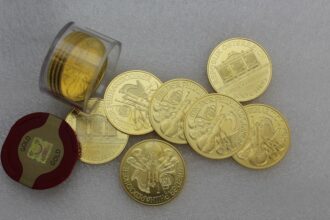Conflict gold refers to gold that is mined in war-torn regions and sold to finance armed conflict, human rights abuses, and other forms of violence. This illicit trade has garnered significant attention over the years, as it intertwines with issues of poverty, exploitation, and environmental degradation. The term “conflict gold” is often associated with countries like the Democratic Republic of the Congo (DRC), where armed groups have historically profited from the extraction and sale of gold, leading to devastating consequences for local populations.
The allure of gold, often referred to as a safe-haven asset, has created a complex web of economic incentives that perpetuate violence and instability in these regions. The ramifications of conflict gold extend far beyond the borders of the countries where it is mined.
As consumers become increasingly aware of the ethical implications of their purchases, the need for transparency and accountability in the gold supply chain has never been more pressing. Understanding the dynamics of conflict gold is crucial for stakeholders at all levels, from policymakers to consumers, as they seek to navigate the challenges posed by this pervasive issue.
Key Takeaways
- Conflict gold fuels violence and human rights abuses in mining communities.
- Key players include armed groups, corrupt officials, and illicit traders profiting from conflict gold.
- International regulations and certification programs are critical to promoting responsible sourcing.
- Technology and partnerships enhance transparency and traceability in the gold supply chain.
- Empowering local miners and reducing global demand are essential steps toward a conflict-free gold industry.
The Impact of Conflict Gold on Communities
The impact of conflict gold on local communities is profound and multifaceted. In regions where gold mining is controlled by armed groups, the consequences are often dire. These groups exploit local populations, forcing them into labor under brutal conditions while reaping the financial benefits of their toil.
Families are often torn apart as individuals are coerced into joining militias or are subjected to violence and intimidation. The social fabric of these communities deteriorates as trust erodes and fear takes hold, leading to a cycle of violence that can persist for generations. Moreover, the environmental consequences of conflict gold mining cannot be overlooked.
Unregulated mining practices often result in significant ecological damage, including deforestation, soil degradation, and water pollution. These environmental issues further exacerbate the challenges faced by local communities, as they rely on natural resources for their livelihoods. The degradation of land and water sources can lead to food insecurity and health problems, compounding the already dire circumstances in which these communities find themselves.
Thus, the impact of conflict gold is not only immediate but also long-lasting, affecting future generations and hindering sustainable development.
Identifying the Key Players in the Conflict Gold Trade

The conflict gold trade involves a range of key players, each contributing to the perpetuation of this illicit industry. At the forefront are armed groups that control mining operations in conflict zones. These groups often use violence and intimidation to maintain their grip on power, exploiting both the land and the people who inhabit it.
Their motivations are typically financial; by selling gold on the black market or through corrupt channels, they can fund their operations and sustain their activities. In addition to armed groups, various intermediaries play a crucial role in the conflict gold supply chain. These intermediaries may include local traders who purchase gold from miners and sell it to larger companies or international markets.
Some may operate with knowledge of the origins of the gold, while others may be oblivious to its conflict-related implications. Furthermore, multinational corporations that source gold for jewelry or electronics can inadvertently contribute to the problem if they do not implement robust due diligence practices. The complexity of this network makes it challenging to trace the origins of gold and hold those responsible accountable.
Strategies for Addressing Conflict Gold at the Source
| Strategy | Description | Key Metrics | Impact |
|---|---|---|---|
| Supply Chain Transparency | Implementing traceability systems to track gold from mine to market. | Percentage of traceable gold, number of audits conducted | Reduces risk of conflict gold entering supply chains |
| Certification Programs | Adopting standards like the Responsible Minerals Initiative or Fairtrade Gold. | Number of certified mines, volume of certified gold produced | Encourages ethical mining practices and consumer trust |
| Community Engagement | Involving local communities in decision-making and benefit-sharing. | Number of community agreements, percentage of local employment | Reduces conflict by addressing grievances and improving livelihoods |
| Conflict-Free Sourcing Policies | Corporate policies to avoid sourcing gold from conflict zones. | Number of companies with policies, compliance rate | Limits funding to armed groups and promotes peace |
| Government Regulation & Enforcement | Strengthening laws and monitoring to prevent illegal mining and trade. | Number of inspections, prosecutions, and regulatory updates | Improves governance and reduces illicit activities |
Addressing conflict gold at its source requires a multifaceted approach that involves collaboration among various stakeholders. One effective strategy is to promote responsible mining practices that prioritize human rights and environmental sustainability. This can be achieved through initiatives that support artisanal miners in transitioning to legal and regulated operations.
By providing training, resources, and access to markets, these initiatives can empower local communities while reducing their reliance on armed groups. Another critical strategy involves enhancing transparency within the supply chain. Implementing traceability systems that track gold from its source to its final destination can help ensure that consumers are not inadvertently supporting conflict-related activities.
This may involve partnerships between governments, NGOs, and private sector actors to create a comprehensive framework for monitoring and reporting on gold sourcing practices. By fostering accountability at every level of the supply chain, stakeholders can work together to dismantle the structures that enable conflict gold to thrive.
The Role of International Regulations and Policies in Ending Conflict Gold
International regulations and policies play a pivotal role in addressing the issue of conflict gold on a global scale. Initiatives such as the OECD Due Diligence Guidance for Responsible Supply Chains provide a framework for companies to assess and mitigate risks associated with sourcing minerals from conflict-affected areas. These guidelines encourage businesses to conduct thorough due diligence on their supply chains, ensuring that they do not contribute to human rights abuses or environmental degradation.
Additionally, regulatory measures such as the Dodd-Frank Act in the United States have sought to increase transparency in the sourcing of conflict minerals, including gold. By requiring companies to disclose their sourcing practices and demonstrate efforts to avoid conflict-related materials, these regulations aim to create a more ethical marketplace. However, enforcement remains a challenge, as many companies may find loopholes or fail to comply with reporting requirements.
Strengthening international cooperation and harmonizing regulations across borders will be essential in creating a unified front against conflict gold.
The Importance of Responsible Sourcing and Certification Programs

Responsible sourcing and certification programs are vital tools in combating conflict gold by promoting ethical practices within the industry. These programs establish standards for sourcing minerals responsibly, ensuring that they are obtained without contributing to violence or human rights abuses. Certification schemes such as the Responsible Gold Mining Principles (RGMP) provide a framework for companies to demonstrate their commitment to ethical sourcing while offering consumers assurance that their purchases do not support conflict.
Moreover, these programs can incentivize companies to invest in sustainable practices that benefit local communities. By prioritizing responsible sourcing, businesses can help create economic opportunities for artisanal miners and promote community development initiatives. This not only contributes to poverty alleviation but also fosters a sense of ownership among local populations over their resources.
As consumers increasingly demand ethically sourced products, certification programs can serve as a powerful mechanism for driving positive change within the gold industry.
Empowering Local Communities and Artisanal Miners
Empowering local communities and artisanal miners is crucial in addressing the root causes of conflict gold. Many artisanal miners operate in informal settings where they lack access to resources, training, and legal protections. By providing support through capacity-building initiatives, stakeholders can help these miners transition into formalized operations that adhere to ethical standards.
Access to fair markets is another essential component of empowerment. By connecting artisanal miners with buyers who prioritize responsible sourcing, they can receive fair compensation for their work while reducing their vulnerability to exploitation by armed groups or intermediaries. Additionally, fostering community engagement in decision-making processes related to mining can help ensure that local voices are heard and respected.
When communities feel empowered and involved in managing their resources, they are more likely to resist coercion from armed groups and work towards sustainable development.
The Role of Technology in Tracking and Monitoring Conflict Gold
Technology has emerged as a powerful ally in the fight against conflict gold by enhancing tracking and monitoring capabilities within the supply chain. Innovations such as blockchain technology offer promising solutions for ensuring transparency and traceability in gold sourcing. By creating immutable records of transactions from mine to market, blockchain can help verify the origins of gold and ensure that it is sourced responsibly.
Additionally, remote sensing technologies can be employed to monitor mining activities in real-time, providing valuable data on environmental impacts and compliance with regulations. Satellite imagery can help identify illegal mining operations or deforestation linked to gold extraction, enabling authorities to take action against violators. By harnessing technology effectively, stakeholders can create a more accountable system that deters conflict-related activities while promoting ethical practices within the industry.
Collaboration and Partnerships in Ending the Trade of Conflict Gold
Collaboration among various stakeholders is essential for effectively addressing the trade of conflict gold. Governments, NGOs, private sector actors, and local communities must work together to create comprehensive strategies that tackle this complex issue from multiple angles. Public-private partnerships can facilitate knowledge sharing and resource mobilization while fostering innovation in responsible sourcing practices.
International organizations also play a crucial role in promoting collaboration by providing platforms for dialogue and cooperation among stakeholders. Initiatives such as the Extractive Industries Transparency Initiative (EITI) encourage governments to disclose information about their natural resource sectors while engaging civil society in monitoring efforts. By fostering collaboration at both local and global levels, stakeholders can build a united front against conflict gold and work towards sustainable solutions.
Addressing the Demand for Conflict Gold in the Global Market
Addressing demand for conflict gold in the global market is critical for curbing its trade. Consumers play a significant role in driving demand for ethically sourced products; therefore, raising awareness about the implications of purchasing conflict gold is essential. Educational campaigns can inform consumers about the importance of responsible sourcing while encouraging them to seek out certified products.
Moreover, businesses must take proactive steps to ensure that their supply chains are free from conflict-related materials. This may involve conducting thorough audits of suppliers and implementing robust due diligence processes to verify sourcing practices. By prioritizing ethical sourcing and transparently communicating these efforts to consumers, companies can help shift market demand towards responsible alternatives.
Moving Towards a Conflict-Free Gold Industry
The journey towards a conflict-free gold industry requires concerted efforts from all stakeholders involved in the supply chain. By addressing the root causes of conflict gold through empowerment initiatives, responsible sourcing practices, and international collaboration, it is possible to create a more ethical marketplace that prioritizes human rights and environmental sustainability. As awareness grows about the implications of purchasing conflict-related materials, consumers have an opportunity to drive change by demanding transparency and accountability from businesses.
Ultimately, moving towards a conflict-free gold industry is not just an ethical imperative; it is essential for fostering peace and stability in regions affected by violence and exploitation. By working together—governments, NGOs, businesses, and local communities—stakeholders can dismantle the structures that enable conflict gold trade while promoting sustainable development for future generations. The path may be challenging, but with commitment and collaboration, a brighter future free from conflict gold is within reach.
To effectively address the issue of conflict gold trade, it is essential to explore various strategies and insights. A related article that delves into this topic can be found on In The War Room, which discusses the implications of conflict minerals and offers potential solutions. For more information, you can read the article [here](https://www.inthewarroom.com/).
WATCH THIS! The Secret War for Africa’s Gold: How Private Armies Fund Global Conflict
FAQs
What is conflict gold?
Conflict gold refers to gold that is mined in areas controlled by armed groups or where mining activities contribute to human rights abuses, environmental damage, or funding of violent conflicts.
Why is it important to stop the trade of conflict gold?
Stopping the trade of conflict gold helps prevent funding of armed groups, reduces human rights violations, promotes ethical mining practices, and supports sustainable development in affected regions.
How can companies ensure they are not buying conflict gold?
Companies can implement due diligence processes, such as tracing the origin of gold, working with certified suppliers, adhering to international standards like the OECD Due Diligence Guidance, and participating in responsible sourcing initiatives.
What role do governments play in stopping conflict gold trade?
Governments can enforce regulations, require transparency in supply chains, support certification schemes, impose sanctions on entities involved in conflict gold trade, and collaborate internationally to monitor and control gold exports.
Are there certification programs for conflict-free gold?
Yes, programs like the Responsible Jewellery Council (RJC) and the Fairtrade Gold certification help verify that gold is sourced responsibly and free from conflict-related issues.
How can consumers contribute to stopping conflict gold trade?
Consumers can support ethical brands, ask retailers about the origin of their gold products, choose certified conflict-free gold, and raise awareness about the impact of conflict gold trade.
What challenges exist in stopping the trade of conflict gold?
Challenges include lack of transparency in supply chains, difficulty in tracing gold origins, weak enforcement of regulations, corruption, and ongoing conflicts in mining regions.
What international laws or guidelines address conflict gold?
International frameworks such as the OECD Due Diligence Guidance for Responsible Supply Chains of Minerals from Conflict-Affected and High-Risk Areas provide guidelines for companies to avoid sourcing conflict gold. Additionally, the Dodd-Frank Act in the U.S. includes provisions related to conflict minerals.




